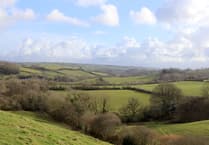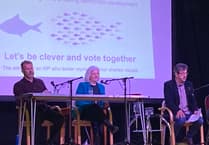A PROPOSED solar farm on land in Diptford has been described as a 'selfish and wilful industrialisation' of the landscape. An application has been lodged with South Hams planners to site 45,000 solar panels across more than 57 acres on Coombeshead Farm in Diptford. A group of local residents have objected to the application declaring that the development will only 'benefit the few and degrade the environment for the many' – and 'can only be described as a blight'. The development could become the fifth solar farm to be built in the Diptford area should the proposals be given the go ahead by the planning committee in two weeks. The residents have been joined by a environmental groups and local MP Dr Sarah Wollaston raising their concerns over the proposals. Dr Wollaston, conservative MP for Totnes, tweeted on Sunday: 'Another 60 acres of beautiful SDevon landscape may soon be lost to large scale solar industrialisation. 'The distorting scale of subsidies is driving the reckless vandalism from large scale solar. Needs to shift to community led, roof top solar.' James Brown, was one of many who wrote letters of objection to South Hams Council detailing the impact the solar farm will bring. He said: 'The declared headlong dash to install rural solar factories on agricultural land in the corridor beside Plymouth Road between the coast Area of Outstanding Natural Beauty and the National Park, is in my opinion, an unacceptable landscape impact and is at the expense of agricultural production and local tourism businesses.' Mr Brown added: 'Many people living near, or passing by, the Hazard/Blue Post/Marley Head industrial aggregation now have a 'view' of thousands of panels between themselves and the moor with more to come perhaps and this can be described as only a blight. 'It is a selfish and wilful industrialisation of the landscape to benefit the very few and degrade the entire environment for many people.' Denise Hawkins also feels that the development will be a blight to the area. She declared: 'The impact is unacceptable in a landscape already blighted by three solar farms; this cumulative impact has reached unacceptable levels detrimental to the existence of this beautiful area's tourism industry and the loss of further farm land. 'The impact on the local neighbourhood and the impact on the environment, ie wildlife habitats and feeding grounds has reached unacceptable levels already. Enough is enough.' However, the application has had a few letters of support, mainly from near neighbours and farmers. Mr and Mrs Gilbert, from Higher Stert Farm, in Diptford, have supported the development claiming that farmers need to make a living. Mr Gilbert said: 'We do not think the development will be intrusive for people living close by, indeed, the lie of the land means that most – although admittedly not all – people close by will not see it from their property. 'We feel that the area will benefit from the land remaining in agriculture as the proposal will graze sheep underneath the panels.' He added: 'In our experience, people in this country do not particularly wish to support production of food products in UK, preferring the lower prices available in other countries as a result of the lower wages paid there. 'For this reason, UK agriculture is suffering at the moment and farms are finding it difficult to make ends meet. 'So if agricultural use of land cannot be supported then other applications will inevitably take their place.' AEE Renewables Group has applied for planning permission to site the solar farm on fields around Coombeshead Farm, Diptford which will turn out 8.88 megawatts of power. And they say that the project will pump almost £32,000 a year into the surrounding communities through the local council. But opponents claim there are already two solar farms in the area and another is just too many. AEE Renewables – which was founded in 1994 as a specialist in renewable energy - unveiled its plans for Coombeshead Farm more than six months ago as it launched a series of consultation meetings with residents at Diptford Village Hall. Its planning application involves siting the thousands of solar panels on fields to the East and South of the farm – enough to power almost 3,000 homes. AAE claims in its application document : 'The relative seclusion of the site and the absence of major environmental sensitivities together with the reduced size of the development means that adverse impacts are largely avoided.' It claims that the planning application addresses 'key issues of concern' raised during the consultation period including 'visibility, biodiversity – mainly bats – flood risk, continued farming and access for HGV's.' It also added: 'An additional benefit to the local community is the recent government decision to allow councils to retain business rates payable for non-domestic renewable energy projects. 'The proposed solar farm would pay business rates – currently around £3,500 per megawatt per year, almost £32,000 per annum for the entire project.' The campaign group of local residents claim that following one of the public meetings with AAE they conducted their own exit poll to see how almost 100 people who attended the meeting felt about the project. 'The result was a staggering 90 per cent vote against,' said Mr Hyde. He dismissed the possible £32,000 a year as a 'bribe' and said: 'This solar farm is just huge. This is not what the countryside is for. Losing farmland to produce electricity from solar panels is not what the South Hams countryside is all about. 'We as a group will be opposing this planning application vigorously. 'We are told this is not grade one farming land but there is no grade one farming land in the area and this land has been happily farmed for thousands of years producing milk and sheep.'
More About:
Comments
This article has no comments yet. Be the first to leave a comment.



